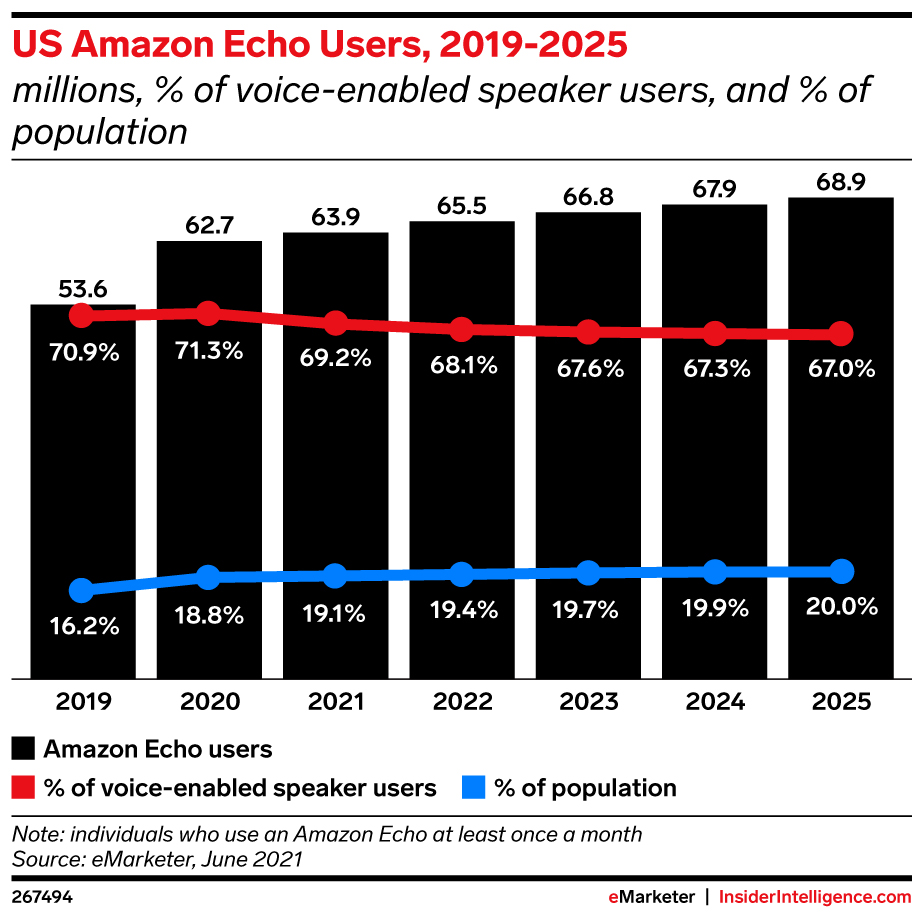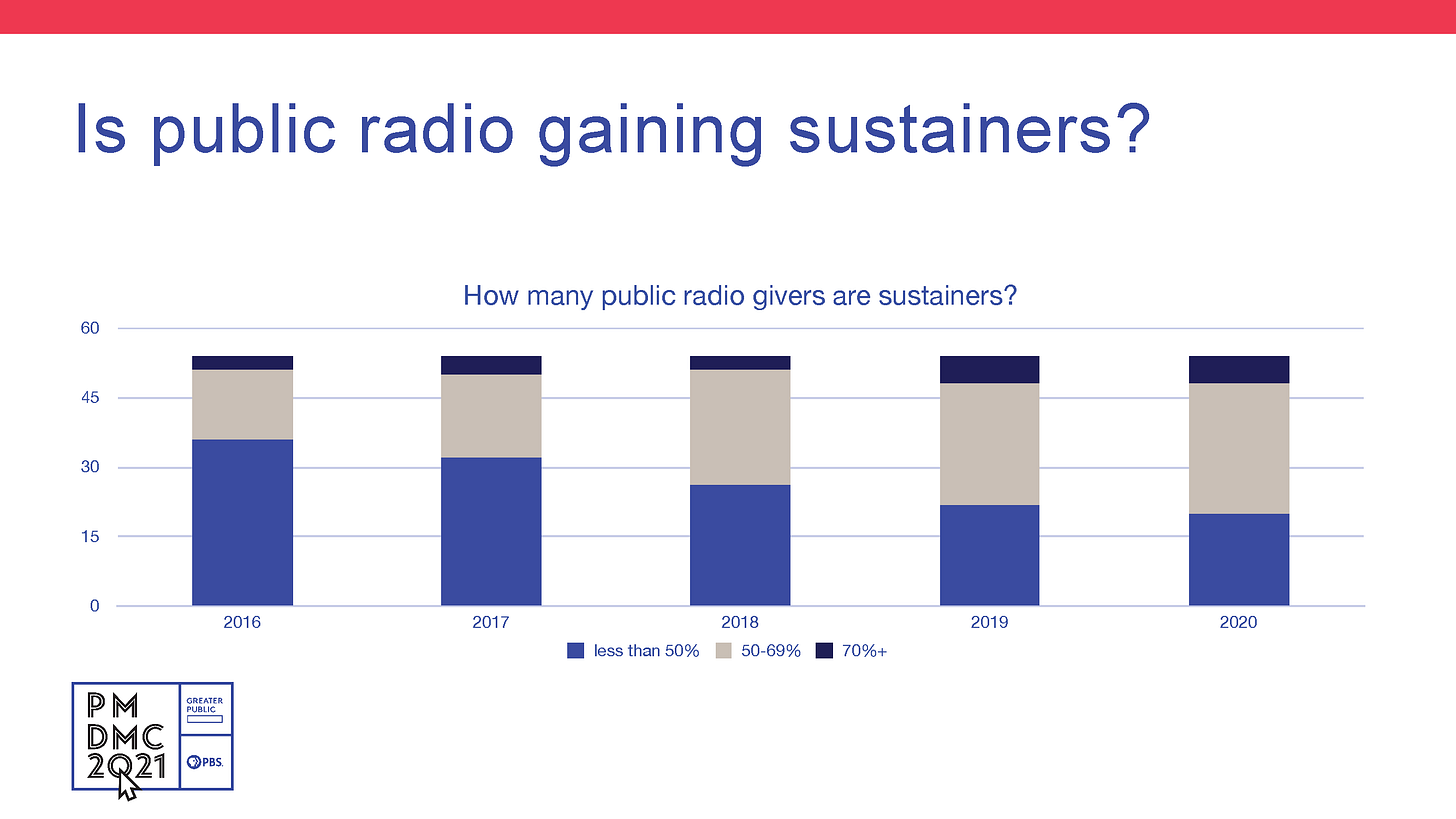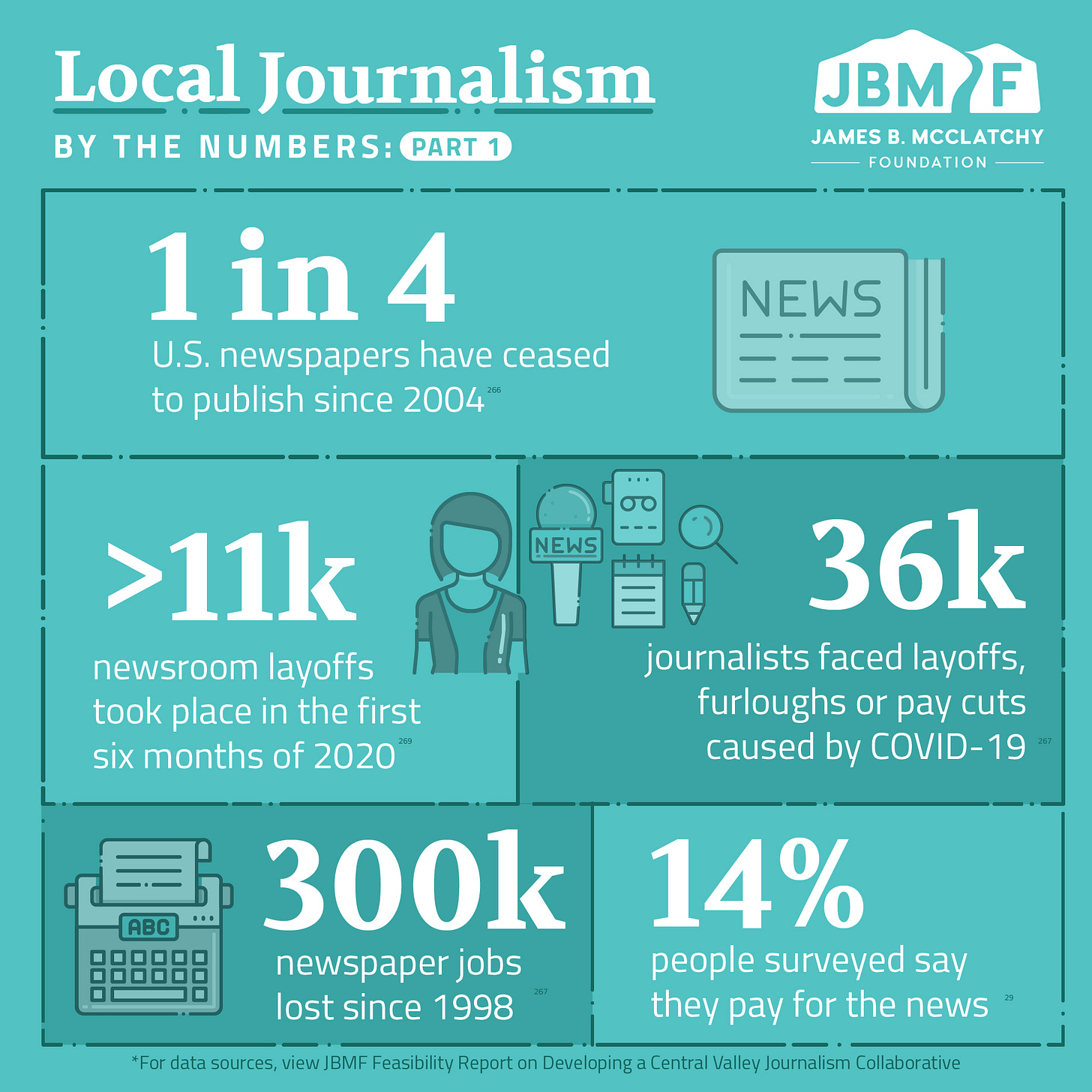This is Three Things for public media leaders for July 29, 2021. Here’s what’s up this week:
The Flattening of the Smart Speaker Market
PMDMC Recap - Part 1: The State of the System
A New Model for Public-Private Partnerships for Local Journalism
THING ONE: Alexa … Why Aren’t More People Using You?
The May 14, 2021 edition of Three Things discussed the 2021 edition of the JacobsMedia annual Techsurvey that brought some insight into media usage for core listeners across broadcast radio. One of the insights in this year’s survey was a slow down in the usage of Smart Speakers, as detailed in the chart below.
New research from eMarketer further supports this research signaling some challenges ahead for in-home listening to audio content. The study focuses specifically on Amazon Echo users showing a decline in market share for the device that also reflects minimal growth of usage of all smart speakers through 2025.
The chart below1 demonstrates the stagnant growth for smart speakers in years ahead, following an increase of more than 16% from 2019 to 2020. The projection suggests that the YoY increase of all smart speaker usage will be less than 2% by 2025. While Amazon is still the dominant player, one must wonder how the company will respond if adoption slows down to such minuscule growth by the middle of the decade.
What’s the reason for this stagnant growth? Most likely is the ongoing privacy concerns. Marketing strategist Cory Treffiletti offered these thoughts on that issue:
For these tools to work, they have to be listening all the time. While Amazon and Apple have said they don’t use the ambient listening for anything specifically, it is still an uncomfortable fact that everything you say in your house is being listened to by someone. They may not retain that data, and they may not use that data (I have my doubts on that one), but the fact that privacy is infringed is enough to stop many people.
I’ve always felt that smart speakers held great promise for in-home listening as a way to counter the decline in actual OTA radio listening taking place in homes. However, this projection raises some red flags for radio, who have made investments, both in technology and marketing, to encourage the use of these devices to listen to streams and podcasts, particularly with younger listeners.
If these trends hold, the mobile phone will continue to serve as the primary device for in- and out-of-the-home listening aside from in-car OTA listening - although the dashboard is constantly evolving, with radio being less prominent with each passing year.
THING TWO: PMDMC — The State of Membership in Public Radio
The Public Media Development | Marketing Conference - known better to most of us as the PMDMC - ended its virtual two-week run last week. My congratulations to Greater Public CEO Joyce MacDonald and her team for pulling off the arduous task of turning one of public media’s major conferences virtual, offering some challenging and inspiring keynotes and good information on various disciplines.
I, personally, wasn’t the biggest fan of the Socio app used for the conference, and I wonder how effective the efforts to get folks to “visit” sponsors worked out, but having the sessions and the chat discussions archived with each session was valuable for the industry.
The State of Membership in Public Media session at the PMDMC has traditionally been one of the go-to sessions, and I want to share a few takeaways from the presentation that featured Jay Clayton, an Individual Giving Advisor at Greater Public, and Deb Ashmore, the Principal Analytics Consultant at Blackbaud Target Analysis. Greater Public’s Melanie Coulson moderated the session.
One aspect that has always been a little frustrating with this presentation is that the data is a year old, as both the Greater Public Benchmarks study and Blackbaud’s donorCentrics report use FY 2020 numbers. Nonetheless, these assessments are always helpful to look at trendlines for the system2.
For starters, I did cringe a bit when Jay referenced Audience ‘98 in his opening comments referring to the research that we know that “listening causes giving.” My intention is not to be critical of Jay because we believe that research still holds in 2021, but it got me thinking about how far behind we are as an industry when we have to reference research that took place when Bill Clinton was President.
We really need to stop doing that. NOW.
The one slide that I want to share from Jay’s presentation looks at the five-year trend for sustaining members in public radio. The continued growth in sustainers coupled with growing major gift philanthropy will be the key to increasing public radio revenue for the foreseeable future. The trends in sustaining memberships for the 54 stations that participated in the benchmarks study every year from 2016 to 2020 are pretty positive.
The chart shows stations moving to 70% or more of their total donor base as sustainers doubled over these five years. In addition, the number of the stations with 50-69% of their donors also doubled, leaving around 30% of the group of 54 stations still with less than half of their donor base giving as sustainers.
For the group at the bottom, this typically means that they are much more reliant on on-air pledge for revenue, and, as Jay notes in the presentation, they are probably struggling to retain donors.
Sustainers retain better than anybody else. Considerably better, in fact. But, Jay points out the challenge in maintaining a strong sustainer program is continent on having a robust recapture program so that sustaining donors don’t drop off your donor base due an expired expired cards or other reasons.
That’s why many of the best membership programs push their sustainers to give via EFT programs3 (as opposed to credit cards) and use their on-air drives almost exclusively to push for new donors to give as sustainers and to convert existing donors to sustaining memberships.
The donorCentrics data mirrored the growth in sustainers (up 36%) across public radio for the same period noting a slight increase in single-gift donors in 2020.
One of the most telling pieces of data from the donorCentrics report looked at new donor trends by quarter, noting how different the period of April - June was for public radio compared to the other three quarters of FY 2020. The impact of the pandemic in that period was evident, particularly when an additional slide shows the growth in 2020 in the share of new donors acquired via digital for both single and sustaining donors. This results from most stations moving away from traditional drives at the onset of the pandemic in mid-March to a focus on digital giving.
A final slide from the donorCentrics presentation looked at the long-term value for donors acquired by the 63 stations in the research pool in 2017. If there is any one slide to demonstrate the importance of building your sustainer program, it’s this one.
A sustaining member acquired in 2017 is more than twice as likely to be still giving to the station in 2020, and the value of that donor over the four years is more than $100 more than a one-time donor. That’s huge!
Deb offered these takeaways at the close of her presentation, encouraging stations to Stay the Course and Embrace the Core:
Refocus efforts to build your sustainer file with direct acquisition – review digital channels for best practices
Concentrate efforts to convert new single gift donors to sustainer
Increase digital and mobile acquisition efforts – digital ads, social media, texting
Increase efforts to acquire and convert donors to EFT Payment Method and consider online payment methods (i.e., PayPal)
Engage with and monitor closely donors that made additional gifts, especially those that did so for the first time in 2020, to encourage repeated multi-gifts in 2021
THING THREE: A Template for Revitalizing Local Journalism
Frequent readers to Three Things know that I’m always on the hunt for information and ideas designed to address the crisis in local news, so it was exciting this week to read about the establishment of the Central Valley Journalism Collaborative. The CVJC is a new infrastructure model dedicated to keeping community journalism thriving in California's Central Valley.
The report released from the James B. McClatchy Foundation (JBMF) titled Feasibility Report on Developing a Central Valley Journalism Collaborative offers a model that focuses on collaboration amongst news organizations in the region, focusing on talent philanthropy and community engagement.
What is so powerful about this report is that it could be something that local public media journalism organizations turn to as an approach to grow and sustain their local news service to communities where few other outlets are providing local news.
The goals in creating the Central Valley Journalism Collaborative serve to guide this proposal:
Protect, sustain, and grow newsroom jobs and coverage capacity
Increase diversity of leadership and reporting workforce to reflect the community
Engage the next generation of consumers and stakeholders
Support local journalism ecosystem innovation
Expand philanthropic investment in the Central Valley
The report suggests that local journalism needs to consider structural changes in how journalism is funded and how philanthropy engages with the sector.
The feasibility report calls for establishing a new nonprofit entity that will serve to aggregate funding from the philanthropic community to fund journalism jobs.
"The future of economic sustainability for local journalism is inextricably linked to the public service it performs. This is why community engagement and impact are central tenets of a new movement of philanthropy, funding critical reporting positions and projects at local newsrooms across the country."
The JBMF is proving an initial $1 million investment as seed money for the Collaborative. Similar to the National Trust for Local News, the Collaborative is prepared to step in to maintain local ownership of the newsroom4.
It’s also refreshing in this report to see the willingness to work with public media to help address the local news crisis in this part of California.
The nonprofit journalism sector is an important ally, and there remains opportunity for nonprofit newsrooms to emerge at scale in the Central Valley. The most important recent example is the Sacramento-based nonprofit newsite CalMatters. While headquartered in Sacramento, its coverage focuses on statewide politics, including the Central Valley. Public media has a bright spot in Capital Public Radio, with news coverage concentrated in the greater Sacramento region, and Valley Public Radio-KVPR has an expanding newsroom. Yet, Central Valley communities, such as Modesto and Merced, are still underserved by public radio and local newsrooms.
More and more often, public media is being looked upon as a pivotal player to address the local news crisis, and we need to be equipped to answer the call. For all the talk of collaboration, we need a national strategy to identify regions where public media organizations can collaborate to make the case similar to how this report addresses the crisis in California’s Central Valley.
If you have thoughts on coordinating this effort into a strategy, I would love to hear from you. Thanks for reading.
The chart titled “Market Growth of Smart Speakers” calculates the overall usage of smart speakers by taking the market share of the Amazon Echo as a percentage of overall usage.
CDP’s ROAR insights provide more timely data, but we need more radio station participation to truly represent the state of membership in public radio. They have the TV side very well covered, however.
The simple reason for this is that donors are much less likely to change bank accounts than dealing with credit card expiration and fraud issues.
The use of Management Service Agreements (aka LMAs) and Joint Operating Agreements are also referenced in the report.










